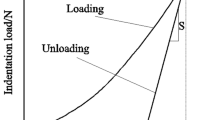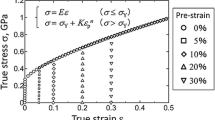Abstract
Indentation tests using a spherical indenter for split-type two half specimens, or the bonded-interface specimens, have been proposed as a means to evaluate the deformation behaviour or the internal damage of materials during indenting the conventional single piece specimen. The purpose of this study is to assess the validity of the split type technique and to better understand the mechanics during the indentation of the split type specimens with respect to the effect of the interface condition between the two split type half blocks. Indentation tests of Al 6065-T5 alloy specimens are chosen to study the whole elasto-plastic stress-strain behaviour. The finite element method was also employed to investigate the deformation behaviour of the two (single piece and split type) test systems loaded with a spherical indenter. The simulated geometry of the specimens and load-displacement curves during indentations are compared with the experimental data of the Al alloy specimens. The similarity and difference in deformation behaviour and stress distribution between the single piece specimen method and the split type specimen method are investigated. The effect of the friction between the two half blocks in the split type specimen test is discussed.
Similar content being viewed by others
References
H. HERTZ, Hertz's Miscellaneous Papers (McMillan, London, 1896) Ch. 5 and 6.
R. H. HEYER, Proc. Am. S. Test. Mat. 37 (1937) 119.
F. GUIBERTEAU, N. P. OADTURE, M. CAI and B. R. LAWN, Phil. Mag. A 68 (1993) 1003.
A. PAJARES, L. WEI, B. R. LAWN, N. P. PADTURE and C. C. BERNDT, Mater. Sci. Eng. A 208 (1996) 158.
N. R. CHITKARA and M. A. BUTT, Int. J. Mech. Sci. 39 (1997) 435.
A. SHAN, I-G. MOON, H-S. KO and J-W. PARK, Scripta Mater. 41 (1999) 353.
E. S. KIM, B. S. CHUN and H. S. KIM, J. Korean Powder Metall. Inst. 3 (1997) 260.
B. P. P. A. GOUVEIA, J. M. C. RODRIGUES and P. A. F. MARTINS, J. Mater. Proc. Technol. 80/81 (1998) 647.
HIBBIT, KARLSSON & SORENSEN INC, ABAQUS 5.7.
N. E. DOWLING, “Mechanical Behaviour of Materials, Engineering Methods for Deformation, Fracture and Fatigue” (Prentice Hall, Englewood Cliffs, 1993) p. 100.
Metal supplier's spec.
H. O'NEILL, “Hardness Measurement of Metals and Alloys,” 2nd edn.(Chapman and Hall Ltd., London, 1967) p. 27. Received 14 May and accepted 28 August 2001 34
Author information
Authors and Affiliations
Corresponding author
Rights and permissions
About this article
Cite this article
Seop Kim, H., Ig Hong, S., Sohn, MS. et al. Experimental and numerical analyses of indentation in single piece and split type specimens. Journal of Materials Science 37, 29–34 (2002). https://doi.org/10.1023/A:1013177304200
Issue Date:
DOI: https://doi.org/10.1023/A:1013177304200




